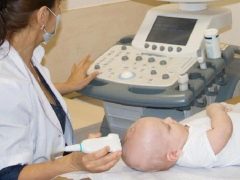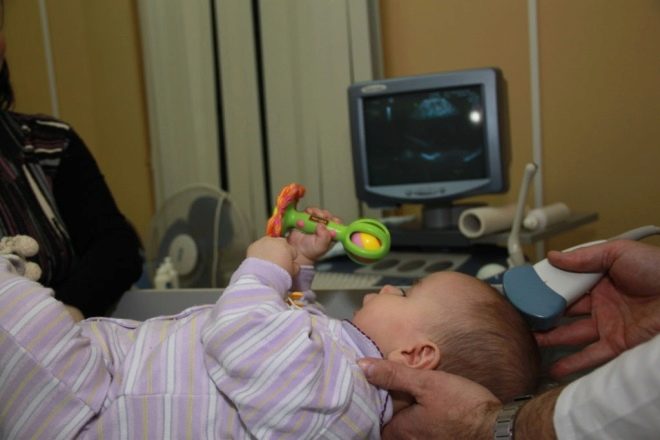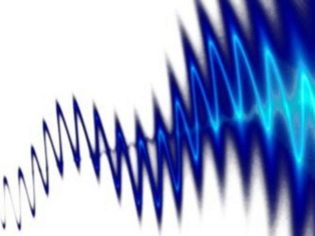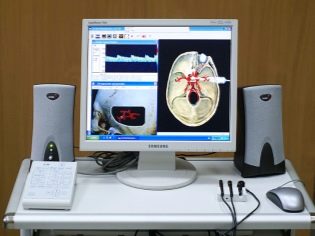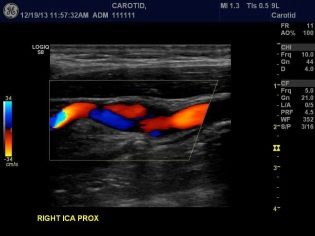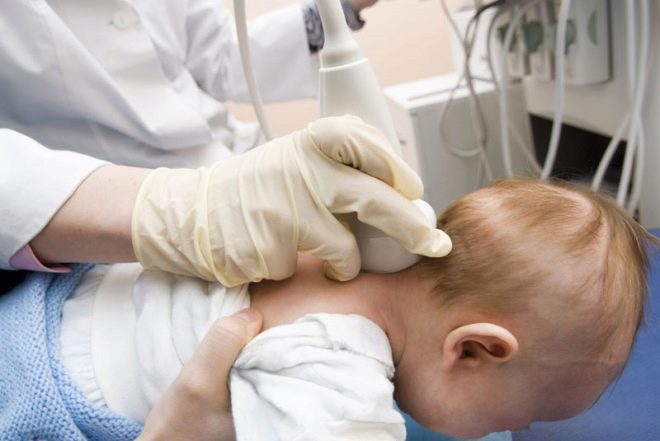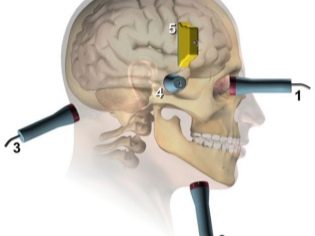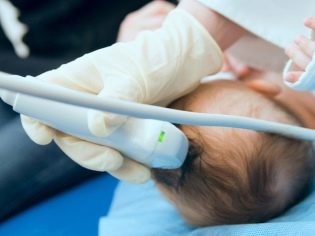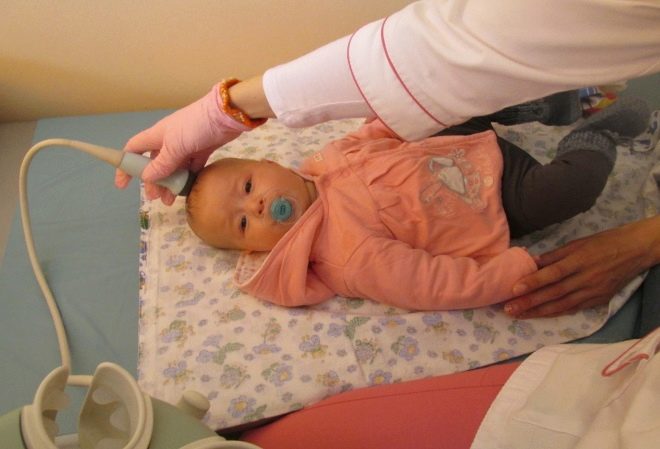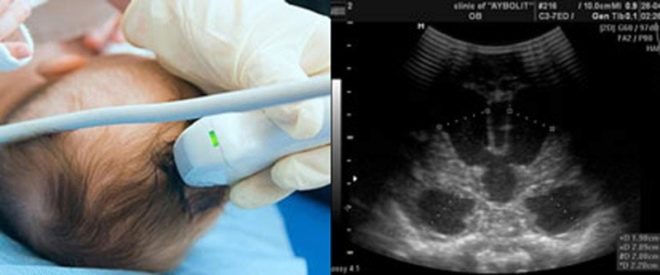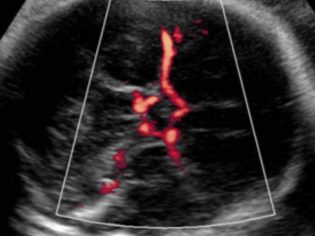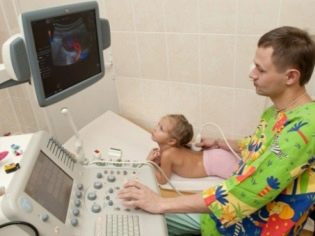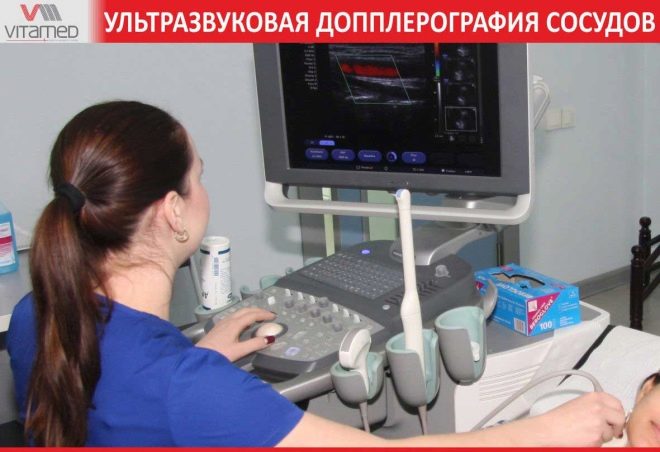USDG of the head and neck vessels to the child
There is a popular opinion among people that problems with vessels are characteristic mainly of adults and even elderly people. However, in childhood, since birth, circulatory disorders occur at least.
Most often babies spend USDG head vessels and neck. About what constitutes this survey, how it is done and what it shows, we will describe in this article.
The essence of the survey
Ultrasound tends to be reflected from tissues and media of different densities. The ultrasound method is based on this.
USDG - Doppler ultrasound is a type of ultrasound scan, only ultrasound waves in this case are not reflected from the organs, but from the red blood cells - large red blood cells. Thus, it becomes possible to measure the speed and volume of blood flow through the vessels. The method allows you to establish how the individual parts of the brain and the whole brain are supplied with blood.
The doppler of the cervical and brain makes it possible to determine with sufficiently high accuracy whether the lumen of the vessels is normal. Conventional ultrasound of blood vessels gives only a general idea of their structure. But the processes that occur in them, are evaluated on the basis of duplex scanning.
For the newborn, infant and older child, the best option for the study is considered to be a duplex, which gives more complete information about the state of the vessels of the head and neck.
Harmful or not?
The dangers of Doppler are mainly spoken by those who have a poor understanding of the principle of this research. Since ultrasound is the basis, then UZDG is considered to be a harmless and completely painless non-invasive method.
Ultrasound does not affect organs, tissues, blood cells, does not cause their mutations, does not impair function. It is only reflected and comes back in the form of a signal on the monitor. So it turns out the image, which on the ultrasound and USDG see the doctor and patient.
The long-term effects of ultrasound on the body are not sufficiently studied; it is this fact that provides food for reasoning against opponents of the method. The fact that there is no information about the harm either, they are usually silent.
Indications
If an ultrasound of the brain is carried out by a child at 1 month without fail, since the study is included in the comprehensive screening of babies, then the USDG is not considered mandatory and is recommended only for those who have certain medical indications.
Doppler sonography may be recommended for infants in case of signs of hypoxia, after head injuries, as well as for babies born as a result of difficult births and birth injuries.
Some neurological abnormalities that a doctor will notice in a baby may also require a separate assessment of cerebral blood supply. These include:
- frequent crying, difficulty falling asleep;
- abundant and regular regurgitation;
- too high or decreased muscle tone;
- lag of the child in physical and mental development.
At an older age, frequent headaches, bouts of dizziness in a child, loss of consciousness, convulsions, frequent nausea and vomiting, and increased fatigue can be the reasons for prescribing a diagnosis.
Children who have already turned 3 years old, UZDG of the vessels of the head and neck are often prescribed because of complaints from parents about restlessness, poor memory, low learning abilities, behavioral problems, speech and psycho-emotional retardation.
Since the procedure is considered to be harmless, parents can do such an examination without a referral from a doctor, for example, visiting a private clinic that specializes in ultrasound examinations for children.
How is it done?
Doppler diagnostics is carried out in the same way as a conventional ultrasound scan, in the same room and on the most common hospital couch. For information use ultrasonic sensor, the results are obtained in two forms - ultrasonic data and Doppler.
The sensor is applied to the child to the location of the important vessels that feed the brain. Such places are located on the back of the head, temples, as well as in the eye area. Vessels of the neck inspect at the location of the patient on the couch on his stomach. The entire examination takes no more than 5-10 minutes.
Mom breastfeeding during the diagnosis held in their hands. Older children may well lie on the couch on their own. But if the child is very afraid, mother is allowed to sit side by side on the couch at the time of the survey.
Do I need training?
Diets and fasting is an ultrasound does not require. If the child is in infancy, try to make sure that at the time of the survey the baby is full and calm. Ideally, if he will undergo the procedure right in a dream. So, before you visit the doctor’s office, feed him well.
Children who have come out of infancy and have already learned to understand what adults are trying to convey to them are advised to tell us in advance as much as possible about what awaits them.
You can take a small object and lead them over the head of the child, "playing" with him in the ultrasound. Then the baby will be psychologically ready for the examination and the chances of sudden hysteria in the doctor’s office will decrease significantly.
Before the examination it is undesirable to give the child strong tea, as well as painkillers and antispasmodic drugs that affect the condition of the blood vessels.
If a child takes certain vascular drugs for life, you should not refuse to take it, but you should be warned by a doctor before starting the study about which drugs, in what dose and for what reason your child receives.
What shows?
The method shows the tone of the vascular walls of the veins and arteries. If the tone is elevated, blood supply may be difficult, which will immediately affect the functioning of the brain and the entire central nervous system.
If there are stenosis (contraction), varicose veins (expansion) or occlusion, the doctor will inform about this, as the blood flow rate will be different from the norm. If necessary, the doctor will evaluate the structure of the walls of blood vessels.
Due to this, it is possible to identify such disorders as minimal brain dysfunction, hypoxia, encephalopathy, increased intracranial pressure. The method is used to assess the extent of damage in meningitis, hydrocephalus, after traumatic brain injury.
If the child is recommended to use USDG of head and neck vessels, it is better to make it. The refusal of parents to have an examination can have extremely negative consequences: problems with the blood circulation of the brain aggravate over time if the child does not receive treatment.
How dopplerography of vessels of the head and a neck is carried out, look further.
